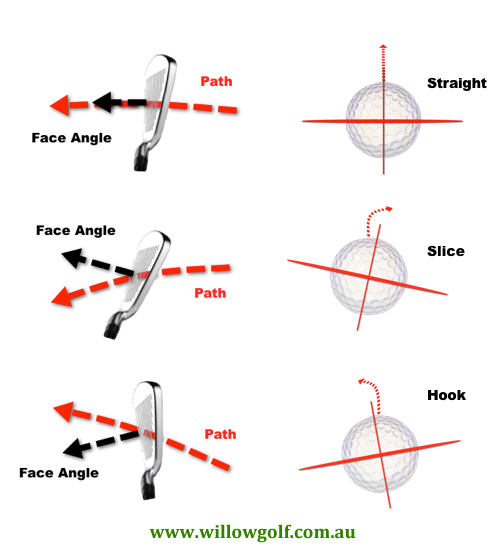
The majority of students that I see will slice the ball. The rest will hook, with few knowing the correct path on the downswing. To learn to hit it straighter, let’s look at why the ball curves in the air.
The main thing that golfers do to curve the ball is to have an open or closed clubface compared to the club’s path through impact.
Gear effect will also cause the ball to curve in the air, even if the path and face angles are both at 0º. Gear effect happens when the ball is struck towards the toe or heel of the club. A ball struck towards the toe will produce draw/hook spin and a ball struck towards the heel will produce fade/slice spin. The path and face angle of the club through impact can directly influence the golfer’s ability to hit the sweet spot on the club face, and have a greater effect on curvature of the ball through the air. So we will focus our attention on the club’s path versus club face angle at impact.
To achieve a straight ball flight, the club face angle must be pointing in line with the club head’s path. i.e. if the club face angle is 0º when compared to the clubhead path (both in the same direction at impact) the ball will fly straight.
When the club head path and club face angle differ, the ball will curve. If the face is open to the clubhead path the ball’s axis will tilt and the ball will fade/slice. Conversely, if the face is closed to the club head path the ball’s axis will tilt and the ball will draw/hook.
The tilting spin axis of the golf ball is exactly like an airplane flying. When it’s flying straight, its wings, or horizontal axis, is level. When it wants to turn, it banks its wings, or tilts its horizontal axis and it turns. The more it tilts its horizontal axis the sharper the plane with turn.
So let’s look at a slice. We know the face is open to the path at impact. Why?
Is the outside-to-in path causing the face to remain open or is the open face causing the golfer to swing across the ball? That’s a chicken or the egg question.

I believe we should correct the face angle first to allow the ball to fly straight in the air and then the golfer should correct the path. An open face at impact can be caused by a number of faults in a swing, but the one thing I nearly always see is the club face not turning back and rolling through impact. The act of moving both arms around the body in a swing should see the hands turning and rolling through impact. The sensation would be that the club face is turning open on the backswing and then rolling closed on the downswing into finish.
One thing that can have a major impact on club face rotation is the grip. A strong grip will usually cause the clubface to close on the way back and the golfer will subconsciously react by attempting to open it on the downswing. This goes against what should happen bio-mechanically so presenting the club face to the ball by manipulating the face will cause inconsistent results in ball flight.
Once the golfer has worked on their neutral grip, the turning open and rolling closed of the club through impact , it shouldn’t take too long to feel how much this needs to occur to produce a straighter ball flight in the air.
If the club’s path is still across the ball the golfer merely needs to feel like they are swinging to the opposite direction.
In the photo, we can see how a typical right-handed golfer who slices the golf ball looks prior to impact on the downswing. The club is above the swing plane and will be therefore be required to swing across the target line through impact. Depending on how much the face remains open to the path, the ball could start slightly left of target but then fade or slice to the right.
To correct the above picture, We must understand that as we are standing side on to the target and swing the club around our body, the club must travel back, up and in on the backswing and should follow a similar path on the downswing. This means the club should not be directly behind and definitely not outside the ball on the downswing. The club head should attack the ball from a diagonal delivery path and square up to the ball at impact.
For a golfer who slices to achieve this, the golfer may feel like they need to hit the ball from in-to-out and roll the face closed to achieve a square impact and square face. If the golfer who has been slicing wants to hit the ball straight they will probably need to feel like they are hitting a draw or hook. The analogy I use for students is to pretend they are playing tennis and are required to hit a top spinning shot down the Right-Hand sideline. Hit out through the ball and roll the hands.
The opposite would also be true if a golfer hooked the ball. The club face is closed to the path to create a draw/hook so the golfer may feel like they need to hit a fade to straighten their ball flight out.




